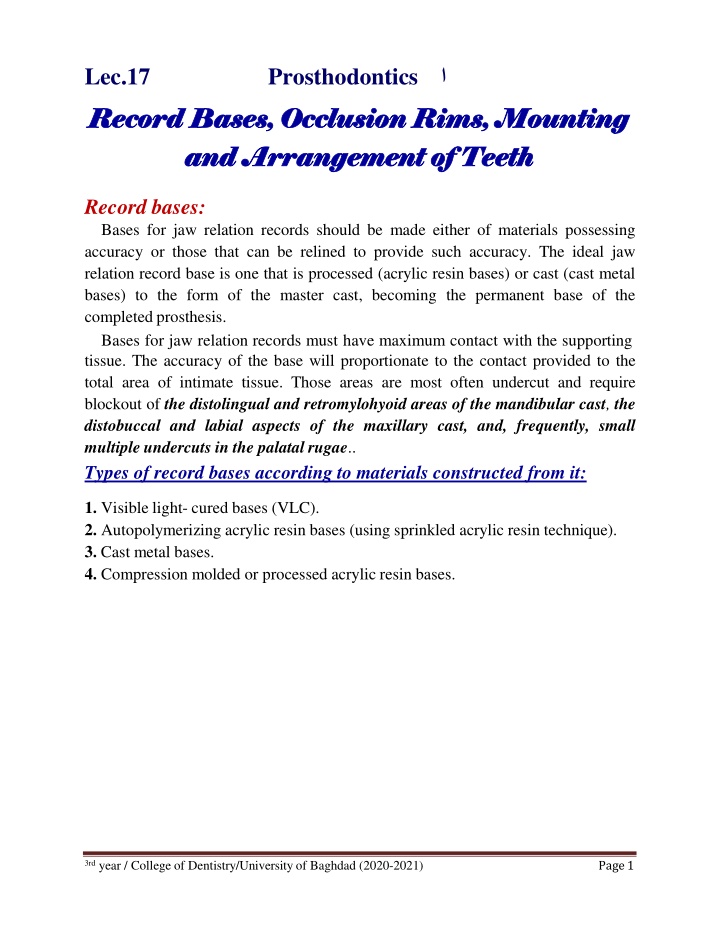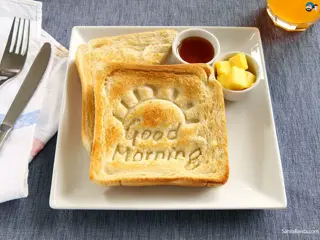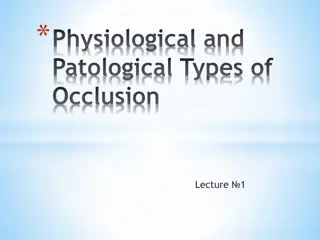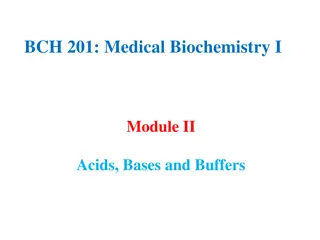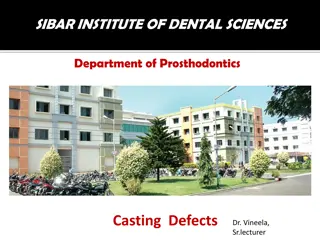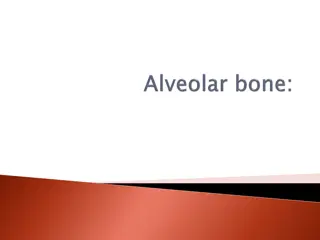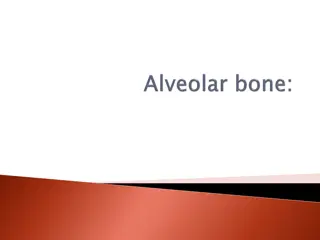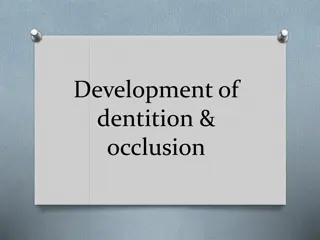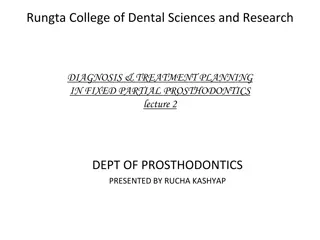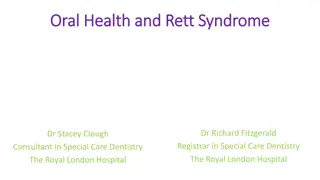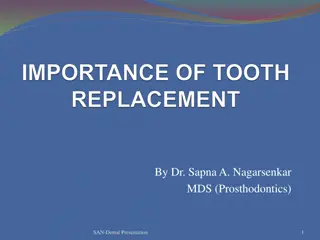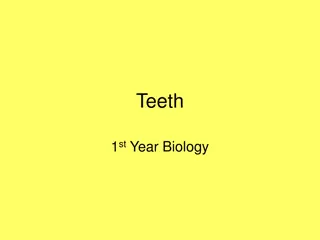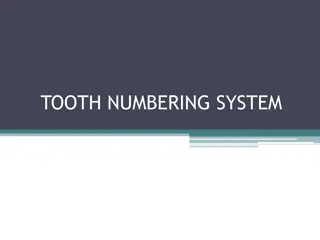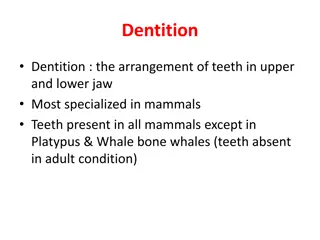Essential Concepts in Prosthodontics: Record Bases, Occlusion Rims, and Teeth Arrangement
Prosthodontics involves the meticulous construction of record bases, occlusion rims, and arrangement of teeth for prosthetic restorations. Record bases must provide accuracy and maximum contact with supporting tissues, utilizing materials like acrylic resin or cast metal. Occlusion rims play a crucial role in recording jaw relations, with options like hard baseplate wax or modeling plastic available for different applications. Proper mounting of casts on an articulator and precise tooth arrangement are essential steps in creating effective prosthodontic appliances.
Download Presentation

Please find below an Image/Link to download the presentation.
The content on the website is provided AS IS for your information and personal use only. It may not be sold, licensed, or shared on other websites without obtaining consent from the author.If you encounter any issues during the download, it is possible that the publisher has removed the file from their server.
You are allowed to download the files provided on this website for personal or commercial use, subject to the condition that they are used lawfully. All files are the property of their respective owners.
The content on the website is provided AS IS for your information and personal use only. It may not be sold, licensed, or shared on other websites without obtaining consent from the author.
E N D
Presentation Transcript
Lec.17 Prosthodontics Record Record Bases, Bases, Occlusion Rims, Mounting Occlusion Rims, Mounting and and Arrangement Arrangement of of Teeth Teeth Record bases: Bases for jaw relation records should be made either of materials possessing accuracy or those that can be relined to provide such accuracy. The ideal jaw relation record base is one that is processed (acrylic resin bases) or cast (cast metal bases) to the form of the master cast, becoming the permanent base of the completed prosthesis. Bases for jaw relation records must have maximum contact with the supporting tissue. The accuracy of the base will proportionate to the contact provided to the total area of intimate tissue. Those areas are most often undercut and require blockout of the distolingual and retromylohyoid areas of the mandibular cast, the distobuccal and labial aspects of the maxillary cast, and, frequently, small multiple undercuts in the palatal rugae.. Types of record bases according to materials constructed from it: 1. Visible light- cured bases (VLC). 2. Autopolymerizing acrylic resin bases (using sprinkled acrylic resin technique). 3. Cast metal bases. 4. Compression molded or processed acrylic resin bases. Page 1 3rd year / College of Dentistry/University of Baghdad (2020-2021)
Occlusion rims: Occlusion rims are added to allow recording of jaw relation records. Placement of wax record is dictated by the opposing tooth position and the supporting ridge character. When possible, the occlusion rim should allow recording of the jaw position within the primary bearing area of the ridge. Occlusion rims may be made of several materials according to method used for recording jaw relation. Occlusion rims for static jaw relation records: The materials of occlusion rims that are used to establish static occlusal relationships include: 1. Hard baseplate wax: most commonly used to establish static occlusal relationship. 2. Wax occlusion rim: registration made on wax occlusion rims using a wax registration material must be handled carefully and mounted immediately on the articulator. As with wax rims, an adjustable frame also may be used to support the final record. 3. Modeling plastic (compound): has several advantages and may be used rather than wax for occlusion rims. Occlusion rims for static jaw relation records should be so shaped that they represent the lost teeth and their supporting structures. An occlusion rim that is too broad and is extended beyond where prosthetic teeth will be located will lead to: 1. Alter the shape of the palatal vault. 2. Alter arch form of the mandibular arch. 3. Crowd the patient s tongue. Page 2 3rd year / College of Dentistry/University of Baghdad (2020-2021)
4. Have an unwelcome effect on the patient. 5. Offer more resistance to jaw relation recording media than will a correctly shaped occlusion rim. Occlusion rims for recording functional or dynamic jaw relationship record: Occlusion rims must be made of a hard wax like inlay waxes. It used for this purpose: 1. Because they can be carved by the opposing dentition. 2. Because most of them are hard enough to support occlusion over a period of hours or days. The construction of this type of occlusion rim consider as chair side procedure rather than a laboratory procedure because it corrected at clinic. Mounting casts on the articulator: Mounting the maxillary and mandibular casts on adjustable articulator in same relationship as they are on the patient by using a face-bow transfer and an accurate centric occlusal relationship record on accurate record bases at establish correct vertical dimension of occlusion. Arrangement of artificial teeth to the opposing cast: Before arrangement of teeth, the denture base on which the jaw relation record has been made must first be removed and discarded (by heating the acrylic resin over a properly adjusted burner and using a pliers to remove the softened material away from the metal framework) unless metal bases are part of denture framework, or heat- polymerized acrylic resin bases were used. Principles that should be taken during arrangement of artificial teeth: 1. In general, the same rules which apply to complete dentures also apply to partial dentures in regard to the arrangement of posterior artificial teeth, however, since the occlusal surfaces of most natural teeth have been altered by wear, artificial teeth should be altered with suitable stones and acrylic burs so that they will properly intercuspate with the natural teeth. So it was preferring to use resin teeth since they are more easily modified and reshaped. 2. The teeth are usually arranged for intercuspation with the opposing teeth in a normal cuspal relationship. Whenever possible, the mesiobuccal cusp of the maxillary first molar should be located in relation to the buccal groove of the Page 3 3rd year / College of Dentistry/University of Baghdad (2020-2021)
mandibular first molar and all other teeth arranged accordingly. However, this classic relationship is not essential to good function and, of course, cannot be achieved in many instances. 3. Artificial posterior tooth forms should be selected to restore the space and fulfill the esthetic demands of the missing dentition. Manufactured tooth forms usually required modification to satisfactorily articulate with an opposing dentition. The original occlusal form, therefore, is of little importance in forming the posterior occlusion for the removable partial denture. 4. The artificial teeth must contact all opposing natural teeth to prevent their extrusion. 5. There is broad agreement that selection posterior teeth with narrow (reduced buccolingual) occlusal surfaces form are desirable. The posterior teeth in this distal extension have been selected with a narrower buccal-lingual width than the original teeth, and they are placed relative to the primary support (buccal shelf) to distribute the functional load to the most anatomically favorable location in a manner that reduces leverage effects. 6. Sometimes a second and /or third molar will be extracted in an arch opposing a removable partial denture to help decrease the length of the occlusal table and thus reduce stress on a free end extension abutment. 7. Artificial posterior teeth should not be arranged farther distally than the beginning of a sharp upward incline of the mandibular residual ridge or over the retromolar pad. To do so would have the effect of shunting the denture anteriorly. Page 4 3rd year / College of Dentistry/University of Baghdad (2020-2021)
Mandibular posterior teeth should not be arranged distal to the upward incline (ascending ramus) of residual ridge. The molar tooth has been placed just anterior to a mark on the cast land area designating the beginning incline. 8. Sometime it may be necessary to select teeth other than those lost by the patient. For example, an artificial second premolar and first molar may be indicated for a space occupied by two molars (first and second molars). Fewer or smaller teeth are often necessary in a tooth bounded edentulous space because the abutments may have drifted toward one another. 9. Esthetic is often a factor in the selection of teeth for partial dentures. The artificial teeth must be at least as long occlusogingivally as the abutment teeth to prevent unwanted display of denture base material. This is particularly important on maxillary partial dentures. 10. Anterior teeth on removable partial dentures are concerned primarily with esthetics and the function of incising. These are best arranged when the patient is present because an added appointment for try-in would be necessary any way. 11. Anterior artificial teeth should be matched as closely as possible to the adjacent natural teeth or fixed restorations. The matching process should be accomplished using natural light and should be completed as quickly as possible to prevent eye fatigue. 12. The selection of teeth for partial dentures replacing anterior teeth is essentially the same as anterior tooth selection for complete dentures. The shade and mold are selected to match the remaining teeth and /or compliment the patient feature. Arrangement of anterior teeth for partial dentures follows the same principles as for arrangement anterior teeth for complete dentures. 13. As a general rule, the most difficult part of arranging anterior denture teeth is directly related to a loss of restorative space. Unless anterior teeth are replaced immediately following their extraction, the natural teeth adjacent to the space will either drift or tilt into the space. The drifting or tilting produces a noticeable decrease in the restorative space and forces the selection of one or more prosthetic teeth that are narrower than their natural counterparts. During the mouth preparation appointment, an attempt should have been made to regain the original width of the space by reshaping the proximal surfaces of the adjacent teeth. If the entire width cannot be recovered, consideration should be given to overlapping the artificial teeth so that a normal-sized tooth may be used to harmonize with the patient s face and remaining teeth. Page 5 3rd year / College of Dentistry/University of Baghdad (2020-2021)
(a) When an anterior tooth is lost, adjacent teeth often drift or tip into the space. (b) This produces a noticeable decrease in restorative space and forces the selection of a replacement that is too narrow. (a) When space has been lost, reshaping of adjacent teeth is indicated. (b)This permits the practitioner to achieve an improved esthetic result. 14. If the maxillary central incisors are missing, it is essential that these teeth be set first. This allows the practitioner to reestablish the maxillary midline in the center of the face. Laboratory procedure of arrangement teeth: Example: arrangement of artificial teeth for chrome cobalt removable partial denture in case of class II (missing first and second molars): The teeth are selected for the mandibular partial denture to fill the existing space. The partial denture framework is placed on cast and stabilized by wax while the teeth are being set. Drop the incisal pin 1mm. This will open the articulator 1mm at the incisal table. Page 6 3rd year / College of Dentistry/University of Baghdad (2020-2021)
The first molar is set into position. The gingival side of the tooth may need to be reduced but should be hollow-ground to preserve the facial surface. Adapt by grinding the mesial surfaces of the first molar so that they fit around the distal of the minor connector; a piece of articulating paper is inserted between the tooth and minor connector and the tooth is wiggled slightly. The marks on the tooth are then reduced. This procedure is repeated untilled the tooth is adapted to the minor connector. Page 7 3rd year / College of Dentistry/University of Baghdad (2020-2021)
The buccal cusp tips of the mandibular first molar are set in the central groove of the opposing tooth. Check to make sure the lingual cusps are in tight contact. After the tooth has been properly positioned, the incisal pin should be returned to its original position and the occlusal surface of the artificial tooth altered with suitable stones and acrylic burs until the incisal pin touches the incisal table (the occlusal surface is altered by reducing the area marked by the articulating paper). Then second molar is set in similar fashion. The second molar is checked for occlusion. Note that the occlusal alteration is done tooth by tooth. Spaces between the mandibular posterior artificial teeth may result during their anteroposterior placement. These spaces are usually dictated by the maxillary natural teeth and are not to be considered undesirable unless they interfere unreasonably with esthetics. Then a compromise position must be selected. Page 8 3rd year / College of Dentistry/University of Baghdad (2020-2021)
